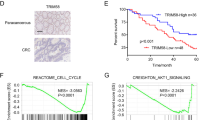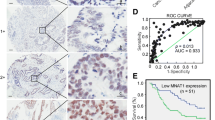Abstract
Pokemon has been showed to directly suppress p14ARF expression and also to overexpress in multiple cancers. However, p14ARF–MDM2–p53 pathway is usually aberrant in colorectal cancer (CRC). The aim is to confirm whether Pokemon plays a role in CRC and explore whether Pokemon works through p14ARF–MDM2–p53 pathway in CRC. Immunohistochemistry for Pokemon, p14ARF and Mtp53 protein was applied to 45 colorectal epitheliums (CREs), 42 colorectal adenomas (CRAs) and 66 CRCs. Pokemon was knocked down with RNAi technique in CRC cell line Lovo to detect mRNA expression of p14ARF with qRT-PCR, cell proliferation with CCK8 assay, and cell cycle and apoptosis with flowcytometry analysis. The protein expression rates were significantly higher in CRC (75.8 %) than in CRE (22.2 %) or CRA (38.1 %) for Pokemon and higher in CRC (53.0 %) than in CRE (0) or CRA (4.8 %) for Mtp53, but not significantly different in CRC (86.4 %) versus CRE (93.3 %) or CRA (90.5 %) for p14ARF. Higher expression rate of Pokemon was associated with lymph node metastasis and higher Duke’s stage. After knockdown of Pokemon in Lovo cells, the mRNA level of p14ARF was not significantly changed, the cell proliferation ability was decreased by 20.6 %, cell cycle was arrested by 55.7 % in G0/G1 phase, and apoptosis rate was increased by 19.0 %. Pokemon enhanced the oncogenesis of CRC by promoting proliferation, cell cycle progression and anti-apoptosis activity of CRC cells independently of p14ARF–MDM2–p53 pathway. This finding provided a novel idea for understanding and further studying the molecular mechanism of Pokemon on carcinogenesis of CRC.





Similar content being viewed by others
References
Barna M, Hawe N, Niswander L, Pandolfi PP. Plzf regulates limb and axial skeletal patterning. Nat Genet. 2000;25(2):166–72. doi:10.1038/76014.
Maeda T, Hobbs RM, Merghoub T, Guernah I, Zelent A, Cordon-Cardo C, et al. Role of the proto-oncogene Pokemon in cellular transformation and ARF repression. Nature. 2005;433(7023):278–85. doi:10.1038/nature03203.
Costoya JA, Hobbs RM, Barna M, Cattoretti G, Manova K, Sukhwani M, et al. Essential role of Plzf in maintenance of spermatogonial stem cells. Nat Genet. 2004;36(6):653–9. doi:10.1038/ng1367.
Maeda T, Hobbs RM, Pandolfi PP. The transcription factor Pokemon: a new key player in cancer pathogenesis. Cancer Res. 2005;65(19):8575–8. doi:10.1158/0008-5472.CAN-05-1055.
Agrawal A, Yang J, Murphy RF, Agrawal DK. Regulation of the p14ARF–Mdm2–p53 pathway: an overview in breast cancer. Exp Mol Pathol. 2006;81(2):115–22. doi:10.1016/j.yexmp.2006.07.001.
Zhao ZH, Wang SF, Yu L, Wang J, Chang H, Yan WL, et al. Overexpression of Pokemon in non-small cell lung cancer and foreshowing tumor biological behavior as well as clinical results. Lung Cancer. 2008;62(1):113–9. doi:10.1016/j.lungcan.2008.02.014.
Chaar I, Amara S, Elamine OE, Khiari M, Ounissi D, Khalfallah T, et al. Biological significance of promoter hypermethylation of p14/ARF gene: relationships to p53 mutational status in Tunisian population with colorectal carcinoma. Tumour Biol. 2014;35(2):1439–49. doi:10.1007/s13277-013-1198-9.
Tachibana M, Kawamata H, Fujimori T, Omotehara F, Horiuchi H, Ohkura Y, et al. Dysfunction of p53 pathway in human colorectal cancer: analysis of p53 gene mutation and the expression of the p53-associated factors p14ARF, p33ING1, p21WAF1 and MDM2. Int J Oncol. 2004;25(4):913–20.
Madoz-Gurpide J, Canamero M, Sanchez L, Solano J, Alfonso P, Casal JI. A proteomics analysis of cell signaling alterations in colorectal cancer. Mol cell Proteomics. 2007;6(12):2150–64. doi:10.1074/mcp.M700006-MCP200.
Zhao X, Ning Q, Sun X, Tian D. Pokemon reduces Bcl-2 expression through NF-kappa Bp65: a possible mechanism of hepatocellular carcinoma. Asian Pac J Trop Med. 2011;4(6):492–7. doi:10.1016/S1995-7645(11)60133-8.
Zhao GT, Yang LJ, Li XX, Cui HL, Guo R. Expression of the proto-oncogene Pokemon in colorectal cancer: inhibitory effects of an siRNA. Asian Pac J Cancer Prev. 2013;14(9):4999–5005.
Flejou JF. WHO classification of digestive tumors: the fourth edition. Ann Pathol. 2011;31(5 Suppl):S27–31. doi:10.1016/j.annpat.2011.08.001.
Fleming M, Ravula S, Tatishchev SF, Wang HL. Colorectal carcinoma: pathologic aspects. J Gastrointest Oncol. 2012;3(3):153–73. doi:10.3978/j.issn.2078-6891.2012.030.
Wu M, Liu Y, Di X, Kang H, Zeng H, Zhao Y, et al. EIF4E over-expresses and enhances cell proliferation and cell cycle progression in nasopharyngeal carcinoma. Med Oncol. 2013;30(1):400. doi:10.1007/s12032-012-0400-z.
Shimizu M, Saitoh Y, Itoh H. Immunohistochemical staining of Ha-ras oncogene product in normal, benign, and malignant human pancreatic tissues. Hum Pathol. 1990;21(6):607–12.
Aggarwal A, Hunter WJ 3rd, Aggarwal H, Silva ED, Davey MS, Murphy RF, et al. Expression of leukemia/lymphoma-related factor (LRF/POKEMON) in human breast carcinoma and other cancers. Exp Mol Pathol. 2010;89(2):140–8. doi:10.1016/j.yexmp.2010.05.002.
Aggarwal H, Aggarwal A, Hunter WJ 3rd, Yohannes P, Khan AU, Agrawal DK. Expression of leukemia/lymphoma related factor (LRF/Pokemon) in human benign prostate hyperplasia and prostate cancer. Exp Mol Pathol. 2011;90(2):226–30. doi:10.1016/j.yexmp.2011.01.003.
Lin CC, Zhou JP, Liu YP, Liu JJ, Yang XN, Jazag A, et al. The silencing of Pokemon attenuates the proliferation of hepatocellular carcinoma cells in vitro and in vivo by inhibiting the PI3K/Akt pathway. PLoS One. 2012;7(12):e51916. doi:10.1371/journal.pone.0051916.
Li Y, Xu S, Wang X, Shi H, Sun Z, Yang Z. Tumor-specific RNA interference targeting Pokemon suppresses tumor growth and induces apoptosis in prostate cancer. Urology. 2013;81(2):467 e1–7. doi:10.1016/j.urology.2012.10.011.
Apostolopoulou K, Pateras IS, Evangelou K, Tsantoulis PK, Liontos M, Kittas C, et al. Gene amplification is a relatively frequent event leading to ZBTB7A (Pokemon) overexpression in non-small cell lung cancer. J Pathol. 2007;213(3):294–302. doi:10.1002/path.2222.
Jeon BN, Yoo JY, Choi WI, Lee CE, Yoon HG, Hur MW. Proto-oncogene FBI-1 (Pokemon/ZBTB7A) represses transcription of the tumor suppressor Rb gene via binding competition with Sp1 and recruitment of co-repressors. J Biol Chem. 2008;283(48):33199–210. doi:10.1074/jbc.M802935200.
Zu X, Ma J, Liu H, Liu F, Tan C, Yu L, et al. Pro-oncogene Pokemon promotes breast cancer progression by upregulating survivin expression. Breast Cancer Res. 2011;13(2):R26. doi:10.1186/bcr2843.
Zhang NN, Sun QS, Chen Z, Liu F, Jiang YY. Homeostatic regulatory role of Pokemon in NF-kappaB signaling: stimulating both p65 and IkappaBalpha expression in human hepatocellular carcinoma cells. Mol Cell Biochem. 2013;372(1–2):57–64. doi:10.1007/s11010-012-1445-1.
Acknowledgments
This study was funded by the Programs for Science and Technology Development of Dongguan (201010815215, 2013108101060 and 2013108106151); the Science and Technology Innovation Fund of Guangdong Medical College (B2011012, B2012017 and B2013009); Science and Technology Planning Project of Guangdong Province (2013B021800061 and 2013B021800062); Medical Science and Technology Research Fund of Guangdong province (B2013291 and A2014471); and the Science and Technology Innovation Project of Department of Education of Guangdong province (2012KJCX0057) and the National Natural Science Foundation of China (81302244).
Conflict of interest
All authors declare that they have no conflict of interest.
Author information
Authors and Affiliations
Corresponding authors
Additional information
Yi Zhao and Yun-hong Yao have contributed equally to this work.
Rights and permissions
About this article
Cite this article
Zhao, Y., Yao, Yh., Li, L. et al. Pokemon enhances proliferation, cell cycle progression and anti-apoptosis activity of colorectal cancer independently of p14ARF–MDM2–p53 pathway. Med Oncol 31, 288 (2014). https://doi.org/10.1007/s12032-014-0288-x
Received:
Accepted:
Published:
DOI: https://doi.org/10.1007/s12032-014-0288-x




